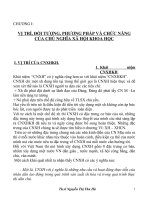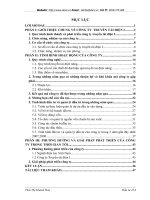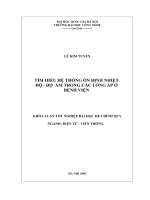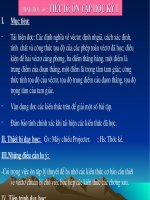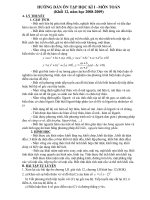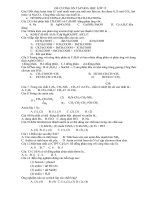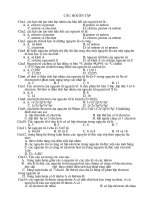On completing this paper, i am specially grateful to my supervisor
Bạn đang xem bản rút gọn của tài liệu. Xem và tải ngay bản đầy đủ của tài liệu tại đây (531.2 KB, 37 trang )
1
PART I. INTRODUCTION
1. Rationale
In the process of worldwide industrialization, the needs for studying English become
more and more inevitable. Especially for the knowledge of the specific job, translators must
understand deeply all the skills of the job and must be ready for the translation into second
language if necessary.
In Vietnam, anyone coming into career, he or she must prepare all the knowledge of
job not only in Vietnamese but in English as well.
Deriving from translating technical documents of the paint company, the researcher
realizes the mistakes in translating paint documents which made by himself or by his
colleagues
Certainly, in order to get the skills of translation better, anyone who works as
translators should analyze thoroughly the mistakes and find out the solutions to correct and
avoid in the future.
2. Aims of study and research questions
Analysis on semantically terminological mistakes in the paint document translation of
specific purpose English is a very complicated matter for the researchers, especially for the
translators in the field of paint terminology in particular and in English in general. The study
aims at:
- Finding out the mistakes in translating paint terminology from English into
Vietnamese with the specific evidences.
- Suggesting the solutions to the problems to improve the current situation of
translating and avoid mistakes in the future.
Thanks to these ideas, the researcher will be aware of some suitable ways to avoid the
mistakes and correct themselves at work.
* Some research questions deducted from the study are as follows:
- What are the mistakes that the translators make when translating the documents?
- What are the solutions to these problems?
2
3. Scope of study
In this study, it is impossible to cover all the mistakes - concerning matters. The
researcher just focuses on the documents that he has been translated from English into
Vietnamese – basing on his experience on the paint document translation. And from
comparison with another 15 translators in 5 sheets of technical documents, the researcher
takes the most popular examples that he has observed, he recognizes three of the most
common mistakes in the translated documents as follows:
- At word level:
Resin (chất tạo màng) is a kind of gelled solution to be the main component of paint
constitution. (Someone translates resin into “nhựa”.)
Vehicle (chất mang, dung môi dẫn) = solvent + binder resin (Someone translates
vehicle into “phương tiện”.)
- At sentence level:
“Technology of Haiphong Paint is under the license of Chugoku-Japan.” Vietnamese
sentence must be “Cơng nghệ Hải Phịng bản quyền của hãng Chugoku – Nhật Bản”, but
some translators take in Vietnamese as “Công nghệ của cơng ty Sơn Hải Phịng là theo li
xăng của hãng Sơn Chugoku – Nhật Bản”.
- At paragraph level
“Of the paint researches that are important not just to the quality of paint but to
water environment, free copper and tin antifouling technologies are improved more and
more, which is the best way of reducing the fouls which hold under the marine vessels,
which are releasing activated biocides that creates antifouling process through the stages of
hydrolysis”. The result should be “Trong số những nghiên cứu về sơn quan trọng không chỉ
đối chất lượng sơn mà cịn với mơi trường biển, cơng nghệ chống hà không chứa hợp chất
cơ thiếc và đồng được chú trọng cải tiến. Phương pháp tốt nhất này là để giải các chất
chống hà và tạo nên quá trình chống hà thông qua các giai đoạn thủy phân”
The investigated issues in relation to the research are as follows:
- A general view of paint technical and other documents
3
- An analysis of the meanings of all the paint terminology and the mistakes created in
translation.
4. Methods of research
Initializing the study, the researcher take advantages of some methods which help him
do the research in the right direction. There are two methods the researcher uses are survey
coming from documents observation and statistics applied with analysis and synthesis.
Encouraging two above methods, the researcher carries out the corresponding tasks as
- Collecting and classifying examples and
- Comparing the usage of language between Vietnamese and English
5. Instruments for data collection, subjects
Deriving from the career, the researcher finds the subject of the study and makes an
effort to deal with. It is obvious that working as a translator of the paint documents, the
researcher has ever got the difficulties in the job. ”Mistakes and how to correct them in
translating”, which is the reason for the subject.
The two data collection instruments used in the study are Description of experience
and Description of observation.
* Description of experience
To fulfill this study, the researcher has worked at Haiphong Paint Join Stock Company
for over 3 years. The experience he can get is through such all the documents he has done
with in translation as Technical data sheets, paint specifications, catalogue, and color
collection cards, etc.
And some international documents which are related to the Paint Marketing and paint
checking are ASTM (American Standard for Testing Measurement), ISO (International
Standard Organization), and JIS (Japanese International Standard), TCVN (Vietnamese
Standard).
Paint companies’ websites are also the resources for the researcher to do the study.
There are so many paint companies in the world. In the fact of worldwide economy, the
competition among companies is higher and more technological, and the information must
4
be updated regularly and immediately. That is the reason why website is a useful instrument
to get the information the most easily.
* Description of observation
The researcher is professional in the field of paint, especially paint document
translation. To help himself be able to understand all the phenomena of paint checking and
inspection, the researcher has ever been trained on paint production, checking and inspection
at Technical center in Japan (2 months), in the laboratory of Haiphong Paint Joint Stock
Company (1 year) and in Technical Service Department (over 2 years). All these things can
improve the knowledge of the researcher in both English and Vietnamese deeply, which can
help the researcher understand and translate paint documents into a second language easily.
6. Methods of data analysis and presentation
The data or documents for this study are analyzed and shown in the methods of
- Overviewing of all the documents and finding out the general mistakes; after that,
- Basing on the research methodology and some kinds of analysis, the researcher shows the
document in the form of the assessment and classification of all the documents.
7. Structure of thesis
Apart from the acknowledgement, table of content and appendices, the thesis is
composed of three main parts:
Part 1. Introduction includes the rationale, aims of study and research questions,
scope of the study, method of research with instruments for data collection, the subject,
methods of data analysis, and presentation.
Part 2. Development consists of three chapters:
Chapter 1. Literature review discusses the definition of translation, the functions of
translation, importance of developing translating skill and the main reasons for translating
mistakes.
5
Chapter 2. Description of selected documents basing on the analysis of
characteristics of paint terminology.
Chapter 3. Mistake analysis, recommendations for mistake correction
Part 3. Conclusion involves a brief summary of main points, some conclusions
induced from the results of the study, limitations of the study and some suggestions for
further study
6
PART II. DEVELOPMENT
CHAPTER 1. LITERATURE REVIEW
This chapter focuses on the theoretical knowledge concerning semantically
terminological mistakes in the paint document translation of specific purpose English
including factors affecting the translation for the people who read and write the paint
technical documents.
1.1. What is translation?
Translation is the interpreting of the meaning of a text and the subsequent production
of an equivalent text, likewise called a "translation," that communicates the same message in
another language. The text to be translated is called the "source text," and the language that it
is to be translated into is called the "target language"; the final product is sometimes called
the "target text." (www.en.wikipedia.org/wiki/Translation). And, “Translation consists of
producing in the target language the closest natural equivalent of the source language
message, firstly with respect to meaning and secondly with respect to style.” Nida (1959)
Often it is rendering meaning of signs, symbols (both verbal and non-verbal) by means
of other signs, symbols in the same language or in other languages. Common sense tells us
that this ought to be simple, as one ought to be able to say something as well in one language
as in another. On the other hand, it may be seen as complicated, artificial and fraudulent,
since by using another language, the language user may be pretending to be someone he/she
is not. Hence, working in translation has its own interests and its own excitement. Since a
translator works on a text, he/she is always trying to extent his/her knowledge and improve
his/her means of expression, he/she is always pursuing facts and words, so a satisfactory
translation is always possible, but a perfect or ideal translated version may never be
obtained.
1.2. Functions of translation
Translation functions as a means of communication and information transferring. It is
used for multilingual notices in public places, for instructions issued by companies, for
technical staffs where it is too often produced from the native into the foreign language by
natives as a matter of nation pride, for official documents such as treaties and contracts, for
7
reports, papers, articles, correspondence, textbooks or for technical documents of for
advertisement, bidding folio, studying specific materials, etc. to convey information, advice
and recommendations for every branch of knowledge. Its volume has increased with the rise
of new technology, the increase in the number of new inventions in science and the growth
of the terminology. In the field of paint, sometimes we read a technical document, it is really
a meaningful word for the daily conversation but it can not be applied for the technical
matter. For example the word “Heavy duty”, may be understood “Nhiệm vụ nặng nề”, but in
all paint documents, we must understand like “Industrial paint”. And this well-known
example is repeatedly reminded by all translators as a valuable experience of profession,
especially when translating such “semi-technical” terms.
Translation is greatly demanded for the need of common understanding among
companies and technicians. Millions of books and texts translated everyday help to transfer
ideas, notions, customs, and beliefs in the paint field to the others. These are absorbed and
considered in various directions and lead to the common agreement at different levels, either
fully or partly accepted.
HOW MANY FORCES PULL A TRANSLATION
According to Peter New mark, a text may be pulled in ten different directions:
1. Source
language writer
2. Source
language norms
9. The truth (the facts
of the matter)
text
3. Source
language culture
4. Source
language settings
and tradition
5. Target language
readership
6. Target language
norms
7. Target language
culture
10. Translator
8. Target language
settings and
tradition
8
Matters discussed in this study are involved in directions 3 and 7 between English and
Vietnamese.
1.3. Importance of developing translating skill
Although translating skill has been cared by anyone who is related to the reading and
writing foreign language technical documents, there are still many problems in reading and
writing, especially in translating. These problems are the results of the translators’
unawareness of the translating skill. Therefore, this section is going to discuss the
importance of translating the paint document along with the analysis of the knowledge for
the translators of paint technical documents.
For the purpose of analysis, language has been divided into different skill areas. These
can be discussed in the framework of how we can understand our first language. A child can
first learn to practice language by speaking, combined with listening. Then, when school
begins, children learn the skills of reading and writing. As the child grows in their language
ability and use, the different skills are most often integrated with each other so that they are
being used in coordination with each other. Thanks to these skills coordination, the
understanding of a language will be developed and can be improved day by day.
In the same way, the understanding of a foreign language can be built up and
developed by learners. They can practice a foreign language day by day to create a new habit
an understanding of a foreign language. That is why the translating skill can be improved
when they read the technical documents daily. After reading and listening, the translator
responds and understands. Just think of all English documents you read in one day and
compare with the documents in Vietnamese. Which do you understand more of? Of course,
Vietnamese is the answer but if you can understand English as well as Vietnamese, you must
practice English translating in daily life.
In a company, while a staff is reading an English document, he may also understand
and translate it into Vietnamese immediately. A qualified translator must have good
background knowledge of the career in both languages - Vietnamese and English. The
meaning of technical terminology is conveyed and understood in contexts. Furthermore, it is
also a requirement that a qualified translator has capability or skills of translating so as to
transfer messages from Vietnamese into English and vice versa.
9
For the purpose of foreign language translating, some translators have memorized
hundreds of words and many grammar rules, but they still cannot translate well. Many
people can read and understand the English technical documents but when they translate
from Vietnamese into English, they cannot. It is true to say that being able to read all the
words in a sentence is quite different from being able to comprehend or understand and
analyze the technical terminologies and the English grammar with meanings. This is very
much like children, when they can read out all the words in the document but they cannot
understand what the meanings of the words are. Moreover, the translators who have not
much exposure to some rarely-used words, they may forget the meaning. They have no
solutions to remember these words, which are easy to understand for all the learners of
English as a second language. But how they can remember these words depends very much
on how often they practice using them or writing them down in the memory books.
In general, all the activities of the translator are aimed to how they can understand
technical terms and translate a technical document into another language. All they have to do
is to have both the knowledge of their specialism or career and the ability of the second
language understanding.
1.4. Reasons for translating mistakes
There are, in fact, many things that contribute to the success of translators. The
followings are some typical factors affecting translating English documents.
1.4.1. Subjective causes
A translation of high quality must be the work of a skillful translator. To be able to
produce good translation, the translator must be competent in both the source and
target languages and have extensive background knowledge of different fields.
1.4.1.1. Insufficient language competence
First and foremost, the practice of translation belongs to the linguistic realm. Thus, the
primary reason of a poor translation must be the insufficiency of the translator’s
language competence. The incompetence may be of Vietnamese, the target language in
English – Vietnamese translation, and/or of English, the source language.
* Insufficient target language (Vietnamese) competence
10
Before becoming a translator, one must be a good writer. That is to say that he/she
is capable of using his mother tongue effectively to express the ideas. Translation,
hence, is most of the time direct consequence of a poor or insufficient target language
competence. In the English – Vietnamese translation, the target language is the Vietnamese
language.
Vietnamese is known for its sophisticated grammatical rules on which not all
Vietnamese people hold appropriate knowledge. In fact, only a few Vietnamese translators
excel at their own mother tongue, let alone students who are still learning to become
translators.
Language incompetence can be observed in the areas: the vocabulary and the
grammatical structures. Insufficient knowledge on either of the two areas may lead to
translations of poor quality.
Noticeably, many would-be translators learning at university nowadays do not know a
remarkably large number of specific Vietnamese words are often
used
in
technical
documents. This causes limitations in their practice of translation when they work for a
company, especially when the text strictly requires proper writing style. “Finish” term likes
these, as observed, in shipbuilding field, it means “hoàn thiện” (complete a ship). In this
case, it is very easy to translate into Vietnamese because it has the same meaning of the daily
life when we do something okay. But in paint field, it means “sơn phủ” (the last paint layer
in the painting system). Some unskilled translators tend to use one neutral word to translate
all words of similar meaning in English for they are unwilling to improve their Vietnamese
vocabulary. They do not have in mind that academic English should be translated into
academic Vietnamese and vice versa. This requires all translators to ceaselessly enlarge their
vocabulary, especially academic ones, which quite a few Vietnamese people lack.
Vietnamese grammatical structures are just as diverse as that of any other
language, sometimes even more. Most Vietnamese people can intuitively use these structures
but fail to connect them with certain foreign language, hence cannot translate naturally.
Besides, Vietnamese language users are known for over-using commas instead of
conjunctions, and run-on sentences. Overcoming these weaknesses is crucial to the
improvement of English – Vietnamese translations.
11
* Insufficient source language (English) competence
It is easy to learn English but it is difficult to master it. The more you learn, the more
complicated you find English is. Almost all English – Vietnamese translators are native
Vietnamese or overseas Vietnamese; therefore, it is difficult for them to have an expert-like
English vocabulary as well as grammatical structures.
Some people think that lack of English language competence is justifiable for
Vietnamese translators because it is not their mother tongue. To my mind, this is a totally
erroneous opinion. To better the quality of translation, translators must master both the
source and the target languages. In other words, before becoming a translator, a person must
first and foremost be a bilingual.
Just like Vietnamese, English contains many word layers, formal or informal. Lack of
vocabulary in any of these layers may cause serious mistakes of a translated text.
Along with a considerable basic vocabulary that can be used in texts neutral in stylistics,
translators must “equip” themselves with terminology vocabulary so as to be as flexible
as possible in their translation. Most Vietnamese unskilled translators lack both the
academic words in their English vocabulary. On the other hand, they tend to abuse the words
and phrases they know and risk making themselves sound improper in certain contexts. For
example, comparing between a sentence in English: “Technology of Haiphong Paint is
under the license of Chugoku-Japan.” and in Vietnamese “Cơng nghệ của cơng ty Sơn Hải
Phịng là theo li xăng của hãng Sơn Chugoku – Nhật Bản”. In the process of translation,
there are wrong habits of the translator. First is Haiphong Paint and “Cơng ty sơn Hải
Phịng” because the translator always considers Haiphong Paint Company is unique. That is
why, as anything about Haiphong Paint is about Haiphong Paint Company. And the same
thing in “License” and “li xăng”. Maybe, “Li xăng” is the borrowing word which has been
used so much by the translator that he forgets the original meaning of “license” to be “bản
quyền”. So Vietnamese sentence must be “Công nghệ Hải Phòng bản quyền của hãng
Chugoku – Nhật Bản”. “License” as you know, has some meanings such as “giấy phép, cấp
quyền, bản quyền, bằng cấp, chứng chỉ, đăng ký”. But in this case, Haiphong Paint
Company has been authorized from Chugoku Company to produce and sell paint products.
The meaning “giấy phép” seems to be used for the laws documents and for registration. But
12
this sentence has been used for advertisement to show the power and authorization. So, we
should understand the suitable meaning like “bản quyền”.
Finally, it is critical to understand that the sufficiency in both languages is not enough
for a translator. He/she needs to flexibly compare and contrast, be aware of the differences
between the two languages so that he/she can easily find an equivalent whenever necessary
or at least know how to make himself/herself understood when encountering untranslatable
concepts. The art of translation requires a lot more than proficiency in languages. This may
explain why bilingual people are not always good translators. One of the other crucial
criteria is the terminology, without which the translation would be made with mistakes.
1.4.1.2. Inadequate terminology
In fact, this includes competent knowledge of almost all aspects, such as
religions, traditional customs, social norms, and historical awareness. In paint industry, we
must understand all kind of paints: paint for ships, for offshore projects, for industry, for
architecture, and so on. Or other fields related to the paint industry such as construction,
shipbuilding industry, traffic road, etc. This kind of combined knowledge can be gained
along with the process of learning English and learning translation. Nevertheless, only a few
translators are aware of this. As a result, after graduating from universities, students know
just a little about the companies today and these companies are related to each other. This is
also the main cause of the so-called “disaster of the translation art”.
It is crucial that translators also pay much attention to their own language, the
Vietnamese language. Delving deeper into this colorful technology, we will see that it is not
easy to be an expert in various Vietnamese techniques. Vietnamese people know about
this but the knowledge they acquire, without their own efforts to explore new things, is
obviously inadequate. Recently, there is a great spreading of learning English of the office
staffs who are working at banks, hotels or companies. One of the big problems here is that
office staffs can do everything in Vietnamese but if there are any documents in foreign
language or even they must contact with foreigners, they get into so much difficulty.
1.4.2. Objective causes
1.4.2.1. Linguistic differences between English and Vietnamese
13
The English language belongs to the Indo-European language family, and the
Vietnamese language belongs to the Austro-Asiatic family. Therefore the two languages
have various differences in terms of vocabulary and grammatical rules. However, with
a view to clarifying one important objective reason of mistakes in English –
Vietnamese translation, some prominent variances are mentioned below:
English grammar is very inflexible compared to other languages. English goes by very
strict structures while the Vietnamese language is much more flexible. For instance, the
Vietnamese language does not always use articles and the rules are not as clear as those of
the English language.
Some English vocabulary is peculiar. A word in English may mean a lot of other
words in Vietnamese. For example, you may translate the word “primer” as “sơn lót”, “sơn
chống rỉ”, “sơn lót phân xưởng”, “sơn lớp 1”, “sơn lớp nền”, …depending on the context.
On the contrary, a Vietnamese word “sơn” has many meanings in translated English
case such as “film”, “coating”, “paint”, “varnish”, “bitumen”, “lacquer”, ”layer” …; or
“mẫu sơn” is the same as “specimen”, “sample”, “panel”… depending on the context.
English, especially American English, has a tendency to convert nouns to verbs.
This is problematic for speakers of the Vietnamese language who cannot as easily convert
nouns to verbs. For examples: a word “weather” you write down in the form of gerund
“weathering” in the sentence “Testing method for coating weathering”. It can be said for
sure that if anyone who knows little about paint field, he/she is more likely to translate into
Vietnamese like this: “Kiểm tra thử q trình phong hóa của màng sơn”. This problem
comes from inexperienced translators. It is completely correct if it is translated into
Vietnamese “Phương pháp thử độ bền thời tiết của sơn”. The word “phong hóa” is only
inferred from the translator who does not know the method and the properties of paint. They
think “Weathering is the decomposition of Earth rocks, soils and their minerals through
direct contact with the planet's atmosphere”, in Vietnamese: “Phong hóa là q trình phá
hủy đá, đất và các khống vật chứa trong đó khi tiếp xúc trực tiếp với mơi trường khơng
khí” ( Paint is also test under the condition
of weather influence, but for the qualified translator, he/she must take in that “weathering”
14
is a testing method for the paint under all the natural and human factors influence happening
in the environment.
All of these peculiarities of English grammar often make it difficult for non- native
English speakers to get a full command of the language. It is also difficult when it comes to
translating English writing into other languages.
1.4.2.2. Career differences
For a translator, the understanding of the terminology in the job he/she translate is very
important. He/she can translate everything but sometimes correctly or incorrectly. The
technicians cannot fully understand it until they look at the translated handouts. Therefore,
only by understanding which career he is in, and which terminology he uses can a translator
make the technician understand the handouts. Translation is not simply a
linguistic
transformation of texts, but it is also a rendering of career concepts from one
language to another. Some careers are in the same row such as Marine time, Shipbuilding,
Construction or Banking, Inspecting, Stock Exchange. Unless a translator is capable of
breaking through “decayed barriers” of his own career competence and opening his mind to
new and sometimes alien concepts, his translation cannot be considered successful.
To conclude this chapter, it is noteworthy that despite many challenges when
translating from English to Vietnamese and despite the actual untranslatability, be it
linguistic or cultural, skilled translators still can, and must, find their own ways to overcome
them to produce a high quality re-creation, not merely a rough combination of words,
“for the sake of pure language” (Venuti, 2000). In other words, there are always
strategies for certain mistakes correction. More details will be discussed in Chapter 3 about
translation strategies and how to avoid mistakes.
CHAPTER 2. DESCRIPTION OF SELECTED DOCUMENTS
This chapter presents the necessary understandings of the paint terminology and its
characteristics, and the documents as well as three types of mistakes will also be described.
2.1. Main characteristics of language of paints
2.1.1. Terminology
15
According to Wikipedia ( terminology is defined as
the study of terms and their use. Terms are words and compound words that are used in
specific contexts. Not to be confused with "terms" in colloquial usages, the shortened form
of technical terms (or terms of art) which are defined within a discipline or specialized field.
The discipline Terminology studies among other things how such terms of art come to be
and their interrelationships within a culture.
Terminology; therefore, denotes a more formal discipline which systematically studies
the labeling or designating of concepts particular to one or more subject fields or domains of
human activities, through research and analysis of terms in context, for the purposes of
documenting and promoting correct usage. This study can be limited to one language or can
cover more than one language at the same time (multilingual terminology, bilingual
terminology, and so forth) or may focus on studies of terms across fields.
Terminology is not connected to information retrieval in any way but focused on the
meaning and conveyance of concepts. "Terms" (i.e. index terms) used in an information
retrieval context are not the same as "terms" used in the context of terminology, as they are
not always technical terms of art.
2.1.2. Characteristics of paint terminology
2.1.2.1. Origin of terminology
Terminology of paint lies in the area of science and technology. The system of
terminology of science and technology is often Latin words such as: otorhinolaryngology,
electro-encephalography, Homo sapiens, biocide, acrylic, epoxy, alkyd, etc or comes from
Latin: “to assert”, “to state”, “to declare” instead of the verbs “to say”, “to contaminate”
instead of the verbs “to soil”, “to purify” instead of the verb “to clean”.
2.1.2.2. Variants of terminology
* Dialects
Dialect is commonly used in a community, a group of people or a specific field. One of
the most characterized variants in English technical documents is geographical dialect
16
between English language of British English and of American English. Take these examples
relating to the dialect of British English and American English:
British English
Depot
Flammable
Gear level
Mobile phone
Polystyrene
American English
Terminal
Inflammable
Stick shift
Cell phone
Styrofoam
* Register
Register is one kind of language variants used for one specific situation, especially in
the field of paint. In three parameters of register which are Field, Tenor and Mode, Field is a
variant used for reflective language to emphasize terminology. In the field of paint
translation, it is very difficult to translate from English into Vietnamese because English in
technical documents has been developed for a long time in the developed countries with high
technology. The challenges in Vietnamese here must be finding out the field of meaning
which has the same one with the long development history of English technical documents.
The most typical examples are words "user-friendly", "environment-friendly", "familyfriendly", “long-live performance” which have different meanings and are translated
generally into Vietnamese "thân thiện với người dùng", thân thiện với mơi trường”, "thân
thiện với gia đình", “Bền mãi với thời gian”. Besides, some terms are rarely used and cannot
be found out in the dictionary of Oxford such as “polymer ester silyl”, “silance",
“cellosovle”, “solvesso”.
2.2. Description of documents
2.2.1. Classifying the documents
In this study, Paint technical documents can take from many places which can be either
the paint specific documents or other documents such as projects, chemistry subjects,
international standard books, construction documents in which there are the components of
paint requirements.
17
Apart from the ordinary documents used for daily conversation such as letters,
contracts, etc. which are used not only in the field of paint but in other industries as well,
there are many types of technical documents.
- Advertisement: Catalogues, color cards
- Technical documents: painting specifications, technical data sheets, safety data
sheets, guidance of paint application, painting maintenance….
- Certificates: product certificates, quality certificates…
- Bidding documents: painting systems applied for the projects, turnover reports…
- Documents for coating testing methods: coming form ASTM, JIS-K (Japan), ISO,
TCVN.
2.2.2. Results from data collection
This section presents the results collected from the survey and from observation of 15
translators who work with 5 types of documents. Of course, in each type of document, there
are many sheets of documents which the translators work with everyday. In the limit of time
and area of presentation, the researcher has worked with 75 sheets of technical documents.
From the observation, three most common mistakes are found out; they are mistakes at
three levels of word, sentence and paragraph. All of them are going to be discussed in the
Chapter 3 after the analysis of the results in this chapter. So, study the below:
Mistake level
Word
Document
Advertisement
Technical documents
Certificates
Bidding documents
Testing methods
R
A
R
S
A
Sentence
R
U
N
S
O
Paragraph
R
U
N
S
O
Table 2.2
(Note: N-never, R-rarely, O-often, S-sometimes, U-usually, A-always is frequency of mistakes)
In the tables 2.2,
N explains for mistakes of 0 translators
18
O explains for mistakes of 0 - 2 translators
S explains for mistakes of 2 – 4 translators
U explains for mistakes of 4 – 8 translators
A explains for mistakes of > 8 translators
From the result of the survey, the some main points will be discussed as follows.
* It is very important that the documents of advertisement and certificates get the
lowest level of mistakes. This can be explained that these types of documents need to be
shown in the world, especially to the customers who buy the paints products. The correctness
must be highest, which helps the manufacturer get the belief from the customers.
On the other hands, these types of documents are quite common and contain a few of
technical words, or they are always in the specific form. That is why they are easy to be
translated with so few mistakes.
* The same explanation for the bidding documents. However, bidding documents are
often longer than certificates and advertisement. They often include at least 5 pages, even
100 pages. It is the reason why the frequency of mistakes in all levels is the problem for the
translators.
* The differences in the documents of technology and testing methods are easily
recognized. Most of these documents are only used for the technicians. They can understand
all the documents, and they apply the knowledge to their experiments. However, in the
translation between English and Vietnamese, the researcher discovers that these documents
contain so many terms (technical words) that make the translators feel dizzy. If there is no
practice in the field of paint, they cannot translate these types of documents. That is why the
mistakes are unavoidable at all levels of word, sentence and paragraph.
In general, this chapter reviews the mistakes levels basing on the characteristics of
paint terminology. All types of document have been scanned by researcher in the appendix
of this thesis. From the researcher’s survey, it has been revealed that the most common
mistakes are at word level. Besides, the mistakes at sentence level and paragraph level are
the important things that need taking care of and avoiding. Coming from these matters,
chapter 3 will be discussed the way how to correct mistakes.
19
CHAPTER 3. MISTAKE ANALYSIS AND RECOMMENDATIONS FOR
MISTAKE CORRECTION
3.1. Mistake analysis
Take a look at these documents:
20
This is the document coming from Japan. It supplies the information of one kind of
paint.
And this is Vietnamese version from an unskilled translator
21
Comparing with the translated version of a skilled one:
22
And now, I will analyze all the mistakes in the way of basing on the collected
documents characteristics. In my opinion, there are three kinds of mistakes that the
translators are more likely to make:
3.1.1. Incompetence in properties of paint
For the best translators, the most important thing is terminology. However,
terminology is used fluently or not, easy to be remembered or not, the translators must
analyze deeply each related word to the field of paint in both English and Vietnamese
languages.
Study these examples:
a. Some words can be translated
Solvent (dung môi) A solvent is a liquid or gas that dissolves a solid, liquid, or
gaseous solute, resulting in a solution. The most common solvent in everyday life is water.
Most other commonly-used solvents are organic (carbon-containing) chemicals. These are
called organic solvents. Solvents usually have a low boiling point and evaporate easily or
can be removed by distillation, leaving the dissolved substance behind.
23
Resin (chất tạo màng) is a kind of gelled solution to be the main component of paint
constitution.
Vehicle (chất mang, dung môi dẫn) = solvent + resin
When looking at the word ”vehicle”, we think it is like ”car”, “truck”, or something
relates to the moving machine. In fact in the field of paint, vehicle is a kind of chemical
substance. The same as the word resin, in Vietnamese, we often consider it “nhựa”, which
leads to wrong translation.
Here are some other examples:
Wall-paint (sơn nước): is the same meaning with emulsion paint
Hardener (đóng rắn): used to make the paint film be created in chemical reaction.
(Someone that does not work in paint will translate “chất làm cứng”)
Silicon Coating: sơn chịu nhiệt
Touch-up: Sơn dặm
Striped coat: Sơn lưng
b. Some words have no Vietnamese equivalent, therefore, cannot be translated into
Vietnamese. Therefore, borrowing is very much likely a solution.
In the technical documents, there are many new words which must be used in English
original sound or word. For example:
Base: the basing substance to constitute a coating
Paste: a kind of coating substance is ready to replace coating with some added
powders.
Etching: is the coating of primer
3.1.2. Context matters
Study these examples:
“Sơn Hải Phòng, niềm tự hào cùng mọi cơng trình bền mãi với thời gian”
In English: “Haiphong paint, the proud with every project long live performance”
24
“Cơng trình”
In English: “Experience”
“Đầu tư”
In English: “Member”
It is clear to see that “Cơng trình” and “Experience”, as well as “Đầu tư” and
“Member” is not correct translation. But in the context of advertising the experience of the
paint projects which Haiphong paint has supplied. In this case, experience means all the
projects in which paint product are used.
In the case of member, in fact, they are the members of Haiphong Paint Joint Stock
Company, they are subsidiary companies. But up to now, they have been running
independently from Haiphong Paint JS Company. That’s why, the capital which is invested
from Haiphong Paint JC Company, is like shareholder.
3.1.3. Habit of English translator
In this part, I would like to mention the bad habit of the translators which is
repeatedly and unconsciously used. Take a look at the following examples:
“Công ty cổ phần Sơn Hải Phòng thành lập ngày 25 tháng 01 năm 1960.
Trên cơ sở kinh nghiệm, công nghệ truyền thống đặc biệt được chuyển giao công nghệ sản
xuất sơn theo Lixăng của hãng Chugoku Marine Paints”
In English: “Haiphong Paint Joint Stock Company was established in 25th January
1960. Basing on the long-timed experience, special technology licensed from Lixang
Technology of Chugoku Marine Paints of Japan”
We can see the bold words. Lixăng is used very naturally because the translators
always hear about the lixăng from Vietnamese people who are not professional in English.
These people often see the word “license” and they understand what it means. In fact,
whenever they want to use it, they use the word “lixăng As a result, what is heard (the
sound) becomes the word in writings.
25
Moreover, when we look at the above paragraph, it appears that the grammar applied is
something wrong. In English version, there is no Subject for the second sentence. The matter
here is mistake in grammar.
In general, there are many mistakes and misunderstanding in the process of translation.
However, if the translators can not correct them immediately, it will become the big
problems in the future. Basing the experience from the colleagues who work as qualified
translators, the would-be translator must make an effort to correct the mistake basing on the
basic grammar and career experience. Some suggested ways to correct the mistakes will be
discussed in section 3.2. below.
3.2. Recommendations for mistake correction
It is highly recommended that translators and translation learners equip
themselves
with as many translation techniques as possible. They may be the strategies to overcome
linguistic difficulties, or the tactics to make your translation widely accepted by target
language readers in specific English terms.
3.2.1. Overcoming linguistic problems
3.2.1.1. Choose the right word
At the level of words, problems can only be solved if the translator works hard to
accumulate both his English and Vietnamese vocabulary to a level that he is capable
of choosing the right word in any case to produce a natural translation.
It is crucial for a translator to fully understand all the denotations and
connotations of a word so that he can avoid making any loss of connotational
meanings. To do that, he also needs flexibility in the use
of
words
and
does
not
translate mechanically basing on an English – Vietnamese dictionary.
Besides, the translator must avoid the rigid use of parts of speech with the
following techniques:
a. Translate English nouns with Vietnamese verbs or adjectives
- Paint is a long-live performance product: Sơn bền mãi với thời gian
